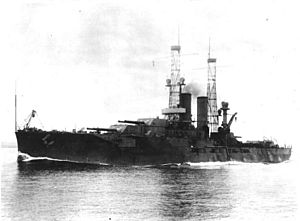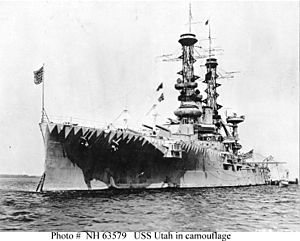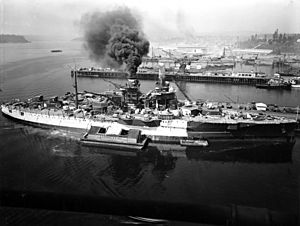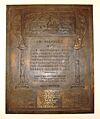USS Utah (BB-31) facts for kids
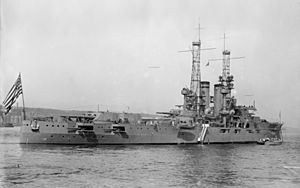
Stern view of Utah (BB-31), at the New York Naval Review.
|
|
Quick facts for kids History |
|
|---|---|
| Name | Utah |
| Namesake | State of Utah |
| Builder | New York Shipbuilding Corporation |
| Laid down | 9 March 1909 |
| Launched | 23 December 1909 |
| Commissioned | 31 August 1911 |
| Decommissioned | 5 September 1944 |
| Stricken | 13 November 1944 |
| Fate | Sunk in Attack on Pearl Harbor, 7 December 1941. Hull near Ford Island. |
| General characteristics | |
| Class and type | Florida-class battleship |
| Displacement | |
| Length | |
| Beam | 88 ft 3 in (26.9 m) |
| Draft |
|
| Installed power |
|
| Propulsion |
|
| Speed | 21 kn (39 km/h; 24 mph) |
| Crew | 1,001 officers and men |
| Armament |
|
| Armor | |
| Notes | 1 battle star awarded |
|
USS Utah wreck
|
|
| Location | Joint Base Pearl Harbor–Hickam, Honolulu, Hawai'i |
| NRHP reference No. | 89001084 |
| Added to NRHP | 5 May 1989 |
The USS Utah (BB-31/AG-16) was a powerful battleship of the United States Navy. She was the second and last ship of the Florida class class. These ships were known as dreadnought battleships, which were large, all-big-gun warships. The Utah was named after the state of Utah. She had one sister ship, the Florida. The Utah was built by the New York Shipbuilding Corporation. Her construction started in March 1909, and she was launched in December of the same year. She was finished and ready for service in August 1911. The Utah was armed with ten large 12-inch guns. These guns were placed in five twin gun turrets.
The Utah and her sister ship Florida were the first US Navy ships to arrive during the United States occupation of Veracruz in 1914. This happened during the Mexican Revolution. Both battleships sent a landing party ashore to begin the occupation of the city. When the United States joined World War I, Utah was sent to Berehaven in Bantry Bay, Ireland. Her job there was to protect groups of supply ships, called convoys, from German warships. Throughout the 1920s, the ship took part in many training exercises. She also carried important people on trips to South America twice, in 1924 and 1928.
In 1931, the Utah was changed from a battleship into a target ship. This was done because of an agreement called the London Naval Treaty. She was given a new designation, AG-16. She was also fitted with many different anti-aircraft guns. These guns were used to train sailors in how to shoot down enemy aircraft. She served in these two roles for the rest of the 1930s. In late 1941, the ship was in Pearl Harbor. On the morning of December 7, during the Japanese attack on Pearl Harbor, Utah was hit by two torpedoes. This caused a lot of water to rush into the ship. The Utah quickly rolled over and sank. Most of her crew managed to escape, but 58 sailors lost their lives. The wreck of the Utah still lies in the harbor today. In 1972, a memorial was built near the ship to honor those who died.
Contents
How Was the USS Utah Designed?
The Utah was 521 ft 6 in (158.95 m) long from end to end. She was 88 ft 3 in (26.90 m) wide and had a draft of 28 ft 6 in (8.69 m). This means she sat 28 ft 6 in (8.69 m) deep in the water. The ship weighed 21,825 long tons (22,175 t) when designed. She could weigh up to 23,033 long tons (23,403 t) when fully loaded.
The ship was powered by four Parsons steam turbines. These engines produced 28,000 shp (20,880 kW) of power. Twelve coal-fired Babcock & Wilcox boilers created the steam for the turbines. This allowed the Utah to reach a top speed of 20.75 kn (38.43 km/h; 23.88 mph). She could travel 5,776 nmi (6,650 mi; 10,700 km) at a speed of 10 kn (19 km/h; 12 mph). The ship had a crew of 1,001 officers and sailors.
The Utah's main weapons were ten 12-inch/45 Mark 5 guns. These were placed in five twin gun turrets. Two turrets were at the front of the ship, one above the other. The other three turrets were at the back. For smaller targets, she had sixteen 5-inch/51 guns. These were placed in armored rooms along the sides of the hull. Like other large warships of that time, she also carried two 21-inch (533 mm) torpedo tubes. These were hidden inside her hull. The ship's main armored belt was 11 in (279 mm) thick. The armored deck was 1.5 in (38 mm) thick. The gun turrets had 12 in (305 mm) thick armor on their front. The conning tower, where the ship was commanded, had 11.5 in (292 mm) thick sides.
What Was the USS Utah's Service History?
Building and Early Years (1909–1922)
The Utah started being built at the New York Shipbuilding Corporation on March 15, 1909. She was launched into the water on December 23, 1909. The ship officially joined the United States Navy on August 31, 1911. After joining, she went on a first trip to test her systems. This trip included stops in places like Hampton Roads, Pensacola, and Guantanamo Bay, Cuba. In March 1912, she joined the Atlantic Fleet. She then took part in gunnery practice.
For the next two years, the Utah did similar training and carried naval cadets. From November 8 to 30, 1913, Utah made a friendly visit to Europe. She stopped in Villefranche, France. In early 1914, the United States decided to get involved in the Mexican Revolution. On April 16, while on her way to Mexico, Utah was ordered to stop a German ship. This ship, the SS Ypiranga, was carrying weapons for the Mexican leader Victoriano Huerta. The arrival of the Ypiranga in Veracruz led the US to occupy the city. Utah and her sister ship Florida were the first American ships there. On April 21, the two ships sent about a thousand Marines and sailors ashore. They began the occupation of the city.
Utah stayed near Veracruz for two months. Then she went back to the New York Navy Yard for repairs in late June. For the next three years, she continued her regular training with the Atlantic Fleet. On April 6, 1917, the United States entered World War I. They declared war on Germany because of its unrestricted submarine warfare against Britain. Utah was stationed in Chesapeake Bay. There, she trained sailors for the rapidly growing fleet. On August 30, 1918, she sailed to Bantry Bay, Ireland. She became the main ship for Battleship Division 6. This group of ships protected convoys in the Western Approaches. They guarded against possible attacks from German warships.
After the war ended in November 1918, Utah visited the Isle of Portland in Britain. In December, she escorted the ship George Washington, which carried President Woodrow Wilson to France for peace talks. Utah returned to New York on December 25. She then went back to her normal training duties. On July 9, 1921, Utah sailed to Europe again. She stopped in Lisbon, Portugal, and Cherbourg, France. She became the main ship for American warships in Europe. She served in this role until October 1922.
Changes and Training (1922–1941)
Utah returned to the US on October 21, 1922. She again became the main ship of Battleship Division 6. In early 1924, Utah took part in large naval exercises called Fleet Problem III. Later that year, Utah was chosen to carry a US diplomatic group. This group was going to a celebration in Peru. She left New York on November 22 with General of the Armies John J. Pershing aboard. They went on a friendly tour of South America. The tour ended when Utah brought Pershing back to New York on March 13, 1925.
Utah was taken out of service on October 31, 1925, for a major upgrade. Her old coal-fired boilers were replaced with new oil-fired ones. Her back cage mast was replaced with a pole mast. She also got a catapult on one of her turrets. This was used to launch floatplanes.
Utah returned to active duty on December 1, 1925. She left Hampton Roads on November 21, 1928, for another South American trip. This time, she picked up President-elect Herbert C. Hoover and his group. She carried them to different cities and then back to the United States.
In 1930, the London Naval Treaty was signed. Because of this treaty, Utah was changed into a radio-controlled target ship. This meant she could be controlled remotely without a crew on board. On July 1, 1931, Utah was renamed "AG-16". All her main and secondary guns were removed. The work was finished by April 1, 1932.
On April 7, Utah left Norfolk for sea trials. These tests were to train her crew and check the radio-control equipment. The ship could be controlled at different speeds and turn in various ways. This allowed her to act like an enemy ship in battle. She passed her radio control tests on May 6. On June 1, the ship was operated by radio control for three hours. On June 9, she sailed to San Pedro, California. There, she joined Training Squadron 1. Starting in late July, the ship began her first target duty. She was used as a target for cruisers and the battleship Nevada. She continued this role for the next nine years. In June 1935, the ship was changed to also train anti-aircraft gunners. She was given a new 1.1-inch/75 caliber anti-aircraft gun for testing.
Utah returned to the Atlantic in January 1939 for more exercises. She then went back to the Pacific, arriving in Pearl Harbor on August 1, 1940. There, she continued anti-aircraft gunnery training. She returned to Pearl Harbor on April 1, 1941. She went to the Puget Sound Navy Yard on May 31 for repairs. She was given new 5-inch/38 caliber dual purpose guns. These improved her ability to train anti-aircraft gunners. She left Puget Sound on September 14, heading back to Pearl Harbor. She continued her duties there for the rest of the year.
The Attack on Pearl Harbor (December 7, 1941)
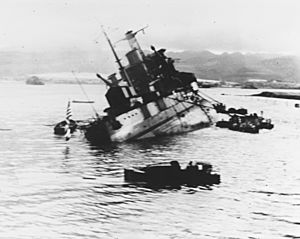
In early December 1941, Utah was docked near Ford Island in Pearl Harbor. She had just finished anti-aircraft gunnery training. Shortly before 8:00 AM on December 7, some sailors on Utah saw the first Japanese planes coming to attack Pearl Harbor. They thought they were American planes at first. The Japanese attack began soon after. Torpedo bombers from Japanese aircraft carriers flew towards Ford Island. They were looking for American aircraft carriers, which usually docked where Utah was. The Japanese pilots realized Utah was not a carrier. However, six torpedo planes still attacked Utah. Two torpedoes hit the battleship, causing serious flooding. Another torpedo missed Utah and hit the cruiser Raleigh.
Water quickly filled the Utah, and she began to lean to her left side. She also started to sink by her back end. As the crew began to leave the ship, one sailor, Chief Watertender Peter Tomich, stayed below deck. He wanted to make sure as many men as possible could escape. He also tried to keep important machines running. He was later given the Medal of Honor for his brave actions. At 8:12 AM, Utah rolled over onto her side. The sailors who had escaped swam to shore. After reaching shore, the ship's senior officer, Commander Solomon Isquith, heard knocking from men trapped inside the capsized ship. He asked for volunteers to get a cutting torch from another damaged ship. They managed to rescue four trapped men. In total, 58 officers and sailors were killed. However, 461 survived the attack.
Salvage Efforts and Memorial
The Navy decided that Utah was no longer useful on December 29. She was then put under the control of the Pearl Harbor Base Force. After successfully turning the capsized battleship Oklahoma upright, they tried to do the same for Utah. They used 17 winches to try and rotate her. But as Utah was turned, she slid towards Ford Island instead of gripping the harbor bottom. The effort to recover Utah was stopped. She was left rotated 38 degrees from being flat.
The Utah was left where she sank. Unlike other battleships sunk at Battleship Row, she was not considered important enough to fix. She was officially taken out of service on September 5, 1944. She was removed from the Navy's list of ships on November 13. Utah received one battle star for her short service during World War II. Her rusty wreck remains in Pearl Harbor, partly above water. The men who died when Utah sank were never removed from the wreck. Because of this, she is considered a war grave.
Remembering the USS Utah
Around 1950, two memorials were placed at the wreck. They honored the sailors who died during the attack on Pearl Harbor. One is a plaque on the dock north of the ship. The second is a plaque placed on the ship itself. In 1972, a larger memorial was built near the sunken wreck, just off Ford Island. This memorial is now part of the Pearl Harbor National Memorial.
The memorial has a 70-foot (21 m) walkway made of white concrete. It goes from Ford Island out to a 40 by 15 ft (12.2 by 4.6 m) platform in front of the ship. A brass plaque and a flagpole are located there. The memorial is on the northwest side of Ford Island. Only people with military identification can visit it. A color guard watches over the wreck. On July 9, 1988, Utah and Arizona were nominated to be added to the National Historic Landmark list. Both wrecks were added on May 5, 1989. As of 2008, seven former crew members who were on Utah when she sank have had their ashes placed inside the wreck.
Items from the ship are also kept in the Utah State Capitol building. These include parts of the ship's silver service and the captain's clock. The ship's bell was displayed at the University of Utah from the 1960s until 2016. It was then sent for restoration and returned to the University of Utah on December 7, 2017. It is now on display inside the Naval Science Building.
Images for kids
See also
 In Spanish: USS Utah (BB-31) para niños
In Spanish: USS Utah (BB-31) para niños


